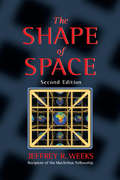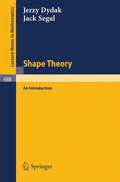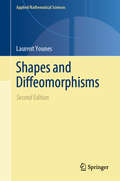- Table View
- List View
The Shape of Space (Chapman & Hall/CRC Pure and Applied Mathematics)
by Jeffrey R. WeeksMaintaining the standard of excellence set by the previous edition, this textbook covers the basic geometry of two- and three-dimensional spaces Written by a master expositor, leading researcher in the field, and MacArthur Fellow, it includes experiments to determine the true shape of the universe and contains illustrated examples and engaging exercises that teach mind-expanding ideas in an intuitive and informal way. Bridging the gap from geometry to the latest work in observational cosmology, the book illustrates the connection between geometry and the behavior of the physical universe and explains how radiation remaining from the big bang may reveal the actual shape of the universe.
The Shape of Space (Chapman And Hall/crc Pure And Applied Mathematics Ser.)
by Jeffrey R. WeeksMaintaining the standard of excellence set by the previous edition, this textbook covers the basic geometry of two- and three-dimensional spaces Written by a master expositor, leading researcher in the field, and MacArthur Fellow, it includes experiments to determine the true shape of the universe and contains illustrated examples and engaging exer
The Shape of Space (Textbooks in Mathematics)
by Jeffrey R. WeeksThe Shape of Space, Third Edition maintains the standard of excellence set by the previous editions. This lighthearted textbook covers the basic geometry and topology of two- and three-dimensional spaces—stretching students’ minds as they learn to visualize new possibilities for the shape of our universe. Written by a master expositor, leading researcher in the field, and MacArthur Fellow, its informal exposition and engaging exercises appeal to an exceptionally broad audience, from liberal arts students to math undergraduate and graduate students looking for a clear intuitive understanding to supplement more formal texts, and even to laypeople seeking an entertaining self-study book to expand their understanding of space. Features of the Third Edition: Full-color figures throughout "Picture proofs" have replaced algebraic proofs Simpler handles-and-crosscaps approach to surfaces Updated discussion of cosmological applications Intuitive examples missing from many college and graduate school curricula About the Author: Jeffrey R. Weeks is a freelance geometer living in Canton, New York. With support from the U.S. National Science Foundation, the MacArthur Foundation and several science museums, his work spans pure mathematics, applications in cosmology and—closest to his heart—exposition for the general public.
The Shape of Space: How To Visualize Surfaces And Three-dimensional Manifolds (Textbooks in Mathematics #Vol. 249)
by Jeffrey R. WeeksThe Shape of Space, Third Edition maintains the standard of excellence set by the previous editions. This lighthearted textbook covers the basic geometry and topology of two- and three-dimensional spaces—stretching students’ minds as they learn to visualize new possibilities for the shape of our universe. Written by a master expositor, leading researcher in the field, and MacArthur Fellow, its informal exposition and engaging exercises appeal to an exceptionally broad audience, from liberal arts students to math undergraduate and graduate students looking for a clear intuitive understanding to supplement more formal texts, and even to laypeople seeking an entertaining self-study book to expand their understanding of space. Features of the Third Edition: Full-color figures throughout "Picture proofs" have replaced algebraic proofs Simpler handles-and-crosscaps approach to surfaces Updated discussion of cosmological applications Intuitive examples missing from many college and graduate school curricula About the Author: Jeffrey R. Weeks is a freelance geometer living in Canton, New York. With support from the U.S. National Science Foundation, the MacArthur Foundation and several science museums, his work spans pure mathematics, applications in cosmology and—closest to his heart—exposition for the general public.
Shape Optimization and Free Boundaries (Nato Science Series C: #380)
by Gert SabidussiShape optimization deals with problems where the design or control variable is no longer a vector of parameters or functions but the shape of a geometric domain. They include engineering applications to shape and structural optimization, but also original applications to image segmentation, control theory, stabilization of membranes and plates by boundary variations, etc. Free and moving boundary problems arise in an impressingly wide range of new and challenging applications to change of phase. The class of problems which are amenable to this approach can arise from such diverse disciplines as combustion, biological growth, reactive geological flows in porous media, solidification, fluid dynamics, electrochemical machining, etc. The objective and orginality of this NATO-ASI was to bring together theories and examples from shape optimization, free and moving boundary problems, and materials with microstructure which are fundamental to static and dynamic domain and boundary problems.
Shape Optimization by the Homogenization Method (Applied Mathematical Sciences #146)
by Gregoire AllaireThis book provides an introduction to the theory and numerical developments of the homogenization method. It's main features are: a comprehensive presentation of homogenization theory; an introduction to the theory of two-phase composite materials; a detailed treatment of structural optimization by using homogenization; a complete discussion of the resulting numerical algorithms with many documented test problems. It will be of interest to researchers, engineers, and advanced graduate students in applied mathematics, mechanical engineering, and structural optimization.
Shape Optimization, Homogenization and Optimal Control: DFG-AIMS workshop held at the AIMS Center Senegal, March 13-16, 2017 (International Series of Numerical Mathematics #169)
by Volker Schulz Diaraf SeckThe contributions in this volume give an insight into current research activities in Shape Optimization, Homogenization and Optimal Control performed in Africa, Germany and internationally. Seeds for collaboration can be found in the first four papers in the field of homogenization. Modelling and optimal control in partial differential equations is the topic of the next six papers, again mixed from Africa and Germany. Finally, new results in the field of shape optimization are discussed in the final international three papers.This workshop, held at the AIMS Center Senegal, March 13-16, 2017, has been supported by the Deutsche Forschungsgemeinschaft (DFG) and by the African Institute for Mathematical Sciences (AIMS) in Senegal, which is one of six centres of a pan-African network of centres of excellence for postgraduate education, research and outreach in mathematical sciences.
Shape Optimization Problems (Springer Optimization and Its Applications #164)
by Hideyuki AzegamiThis book provides theories on non-parametric shape optimization problems, systematically keeping in mind readers with an engineering background. Non-parametric shape optimization problems are defined as problems of finding the shapes of domains in which boundary value problems of partial differential equations are defined. In these problems, optimum shapes are obtained from an arbitrary form without any geometrical parameters previously assigned. In particular, problems in which the optimum shape is sought by making a hole in domain are called topology optimization problems. Moreover, a problem in which the optimum shape is obtained based on domain variation is referred to as a shape optimization problem of domain variation type, or a shape optimization problem in a limited sense. Software has been developed to solve these problems, and it is being used to seek practical optimum shapes. However, there are no books explaining such theories beginning with their foundations.The structure of the book is shown in the Preface. The theorems are built up using mathematical results. Therefore, a mathematical style is introduced, consisting of definitions and theorems to summarize the key points. This method of expression is advanced as provable facts are clearly shown. If something to be investigated is contained in the framework of mathematics, setting up a theory using theorems prepared by great mathematicians is thought to be an extremely effective approach. However, mathematics attempts to heighten the level of abstraction in order to understand many things in a unified fashion. This characteristic may baffle readers with an engineering background. Hence in this book, an attempt has been made to provide explanations in engineering terms, with examples from mechanics, after accurately denoting the provable facts using definitions and theorems.
Shape Optimization under Uncertainty from a Stochastic Programming Point of View (Stochastic Programming)
by Harald HeldOptimization problems are relevant in many areas of technical, industrial, and economic applications. At the same time, they pose challenging mathematical research problems in numerical analysis and optimization. Harald Held considers an elastic body subjected to uncertain internal and external forces. Since simply averaging the possible loadings will result in a structure that might not be robust for the individual loadings, he uses techniques from level set based shape optimization and two-stage stochastic programming. Taking advantage of the PDE’s linearity, he is able to compute solutions for an arbitrary number of scenarios without significantly increasing the computational effort. The author applies a gradient method using the shape derivative and the topological gradient to minimize, e.g., the compliance and shows that the obtained solutions strongly depend on the initial guess, in particular its topology. The stochastic programming perspective also allows incorporating risk measures into the model which might be a more appropriate objective in many practical applications.
Shape-Preserving Approximation by Real and Complex Polynomials
by Sorin G. GalFirst comprehensive treatment in book form of shape-preserving approximation by real or complex polynomials in one or several variables Of interest to grad students and researchers in approximation theory, mathematical analysis, numerical analysis, Computer Aided Geometric Design, robotics, data fitting, chemistry, fluid mechanics, and engineering Contains many open problems to spur future research Rich and updated bibliography
Shape Reconstruction from Apparent Contours: Theory and Algorithms (Computational Imaging and Vision #44)
by Giovanni Bellettini Valentina Beorchia Maurizio Paolini Franco PasquarelliMotivated by a variational model concerning the depth of the objects in a picture and the problem of hidden and illusory contours, this book investigates one of the central problems of computer vision: the topological and algorithmic reconstruction of a smooth three dimensional scene starting from the visible part of an apparent contour.The authors focus their attention on the manipulation of apparent contours using a finite set of elementary moves, which correspond to diffeomorphic deformations of three dimensional scenes.A large part of the book is devoted to the algorithmic part, with implementations, experiments, and computed examples. The book is intended also as a user's guide to the software code appcontour, written for the manipulation of apparent contours and their invariants. This book is addressed to theoretical and applied scientists working in the field of mathematical models of image segmentation.
Shape Theory and Geometric Topology: Proceedings of a Conference Held at the Inter-University Centre of Postgraduate Studies, Dubrovnik, Yugoslavia, January 19-30, 1981 (Lecture Notes in Mathematics #870)
by S. Mardesic J. SegalShapes and Diffeomorphisms (Applied Mathematical Sciences #171)
by Laurent YounesThis book covers mathematical foundations and methods for the computerized analysis of shapes, providing the requisite background in geometry and functional analysis and introducing various algorithms and approaches to shape modeling, with a special focus on the interesting connections between shapes and their transformations by diffeomorphisms. A direct application is to computational anatomy, for which techniques such as large‒deformation diffeomorphic metric mapping and metamorphosis, among others, are presented. The appendices detail a series of classical topics (Hilbert spaces, differential equations, Riemannian manifolds, optimal control).The intended audience is applied mathematicians and mathematically inclined engineers interested in the topic of shape analysis and its possible applications in computer vision or medical imaging. The first part can be used for an advanced undergraduate course on differential geometry with a focus on applications while the later chapters are suitable for a graduate course on shape analysis through the action of diffeomorphisms. Several significant additions appear in the 2nd edition, most notably a new chapter on shape datasets, and a discussion of optimal control theory in an infinite-dimensional framework, which is then used to enrich the presentation of diffeomorphic matching.
Shapes and Diffeomorphisms (Applied Mathematical Sciences #171)
by Laurent YounesShapes are complex objects to apprehend, as mathematical entities, in terms that also are suitable for computerized analysis and interpretation. This volume provides the background that is required for this purpose, including different approaches that can be used to model shapes, and algorithms that are available to analyze them. It explores, in particular, the interesting connections between shapes and the objects that naturally act on them, diffeomorphisms. The book is, as far as possible, self-contained, with an appendix that describes a series of classical topics in mathematics (Hilbert spaces, differential equations, Riemannian manifolds) and sections that represent the state of the art in the analysis of shapes and their deformations. A direct application of what is presented in the book is a branch of the computerized analysis of medical images, called computational anatomy.
Shapes and Sizes (tactile)
by Adrian FarnsworthOn each of these six pages there are two or three images of different sized shapes to find. They can be used as large print or tactile.
The Shaping of Arithmetic after C.F. Gauss's Disquisitiones Arithmeticae
by Catherine Goldstein Norbert Schappacher Joachim SchwermerSince its publication, C.F. Gauss's Disquisitiones Arithmeticae (1801) has acquired an almost mythical reputation, standing as an ideal of exposition in notation, problems and methods; as a model of organisation and theory building; and as a source of mathematical inspiration. Eighteen authors - mathematicians, historians, philosophers - have collaborated in this volume to assess the impact of the Disquisitiones, in the two centuries since its publication.
Shaping Space: Exploring Polyhedra in Nature, Art, and the Geometrical Imagination
by Marjorie SenechalThis second edition is based off of the very popular Shaping Space: A Polyhedral Approach, first published twenty years ago. The book is expanded and updated to include new developments, including the revolutions in visualization and model-making that the computer has wrought. Shaping Space is an exuberant, richly-illustrated, interdisciplinary guide to three-dimensional forms, focusing on the suprisingly diverse world of polyhedra. Geometry comes alive in Shaping Space, as a remarkable range of geometric ideas is explored and its centrality in our cultre is persuasively demonstrated. The book is addressed to designers, artists, architects, engineers, chemists, computer scientists, mathematicians, bioscientists, crystallographers, earth scientists, and teachers at all levels—in short, to all scholars and educators interested in, and working with, two- and three-dimensinal structures and patterns.
Shared Beginnings, Divergent Lives: Delinquent Boys To Age 70
by John H. LAUB Robert J. SampsonThis book analyzes newly collected data on crime and social development up to age 70 for 500 men who were remanded to reform school in the 1940s. Born in Boston in the late 1920s and early 1930s, these men were the subjects of the classic study Unraveling Juvenile Delinquency by Sheldon and Eleanor Glueck (1950). Updating their lives at the close of the twentieth century, and connecting their adult experiences to childhood, this book is arguably the longest longitudinal study of age, crime, and the life course to date. John Laub and Robert Sampson's long-term data, combined with in-depth interviews, defy the conventional wisdom that links individual traits such as poor verbal skills, limited self-control, and difficult temperament to long-term trajectories of offending. The authors reject the idea of categorizing offenders to reveal etiologies of offending--rather, they connect variability in behavior to social context. They find that men who desisted from crime were rooted in structural routines and had strong social ties to family and community. By uniting life-history narratives with rigorous data analysis, the authors shed new light on long-term trajectories of crime and current policies of crime control. Table of Contents: Acknowledgments 1. Diverging Pathways of Troubled Boys 2. Persistence or Desistance? 3. Explaining the Life Course of Crime 4. Finding the Men 5. Long-Term Trajectories of Crime 6. Why Some Offenders Stop 7. Why Some Offenders Persist 8. Zigzag Criminal Careers 9. Modeling Change in Crime 10. Rethinking Lives in and out of Crime Notes References Index The accounts of individuals are quite riveting, and the book can be recommended strongly purely for the stories provided about diverse lives. However, the book is much, much more than that in terms of the serious challenge that the authors' findings and ideas present to some of the leading contemporary theories of both crime and development. A highly original and scholarly contribution of the highest quality.--Sir Michael Rutter, Institute of Psychiatry, King's College LondonShared Beginnings, Divergent Lives is an extraordinary work which shows the deep insights gained by studying the whole life course, beginning in childhood and ending in later life. With access to a rare data archive, the authors provide compelling evidence on the remarkably varied adult lives of teenage delinquents who grew up in low-income areas of Boston (born 1925-1935). The story behind these varied life paths and their consequences inspires fresh thinking about crime over the life course through models of life trajectories and vivid narratives that reveal the complexity of lives.--Glen H. Elder, Jr., University of North Carolina at Chapel HillThis book redraws the landscape of developmental criminology that Laub and Sampson already have done so much to define, setting new standards and benchmarks along the way. The authors both provide new evidence for earlier conclusions and challenge prevailing assumptions and assertions, thereby reshaping the criminological research agenda for years to come.--John Hagan, Northwestern University
Shared Beginnings, Divergent Lives: Delinquent Boys to Age 70
by John H. Laub Robert J. SampsonThis book analyzes newly collected data on crime and social development up to age 70 for 500 men who were remanded to reform school in the 1940s. Born in Boston in the late 1920s and early 1930s, these men were the subjects of the classic study Unraveling Juvenile Delinquency by Sheldon and Eleanor Glueck (1950). Updating their lives at the close of the twentieth century, and connecting their adult experiences to childhood, this book is arguably the longest longitudinal study of age, crime, and the life course to date. John Laub and Robert Sampson's long-term data, combined with in-depth interviews, defy the conventional wisdom that links individual traits such as poor verbal skills, limited self-control, and difficult temperament to long-term trajectories of offending. The authors reject the idea of categorizing offenders to reveal etiologies of offending--rather, they connect variability in behavior to social context. They find that men who desisted from crime were rooted in structural routines and had strong social ties to family and community. By uniting life-history narratives with rigorous data analysis, the authors shed new light on long-term trajectories of crime and current policies of crime control.
Shared Physical Custody: Interdisciplinary Insights in Child Custody Arrangements (European Studies of Population #25)
by Laura Bernardi Dimitri MortelmansThis open access book provides an overview of the ever-growing phenomenon of children in shared physical custody thereby providing legal, psychological, family sociological and demographical insights. It describes how, despite the long evolution of broken families, only the last decade has seen a radical shift in custody arrangements for children in divorced families and the gender revolution in parenting which is taking place. The chapters have a national or cross-national perspective and address topics like prevalence and types of shared physical custody, legal frames regulating custody arrangements, stability and changes in arrangements across the life course of children, socio‐economic, psychological, social well-being of various family members involved in different custody arrangements. With the book being an interdisciplinary collaboration, it is interesting read for social scientists in demography, sociology, psychology, law and policy makers with an interest family studies and custody arrangements.
Shared Space: Folklife In The Arizona-sonora Borderlands
by James GriffithWhere it divides Arizona and Sonora, the international boundary between Mexico and the United States is both a political reality, literally expressed by a fence, and, to a considerable degree, a cultural illusion. Mexican, Anglo, and Native American cultures straddle the fence; people of various ethnic backgrounds move back and forth across the artificial divide, despite increasing obstacles to free movement. On either side is found a complex cultural mix of ethnic, religious, and occupational groups. In A Shared Space James Griffith examines many of the distinctive folk expressions of this varied cultural region.
Sharing Economy and Big Data Analytics
by Soraya Sedkaoui Mounia KhelfaouiThe different facets of the sharing economy offer numerous opportunities for businesses ? particularly those that can be distinguished by their creative ideas and their ability to easily connect buyers and senders of goods and services via digital platforms. At the beginning of the growth of this economy, the advanced digital technologies generated billions of bytes of data that constitute what we call Big Data. This book underlines the facilitating role of Big Data analytics, explaining why and how data analysis algorithms can be integrated operationally, in order to extract value and to improve the practices of the sharing economy. It examines the reasons why these new techniques are necessary for businesses of this economy and proposes a series of useful applications that illustrate the use of data in the sharing ecosystem.
Sharing Economy and Big Data Analytics
by Soraya Sedkaoui Mounia KhelfaouiThe different facets of the sharing economy offer numerous opportunities for businesses ? particularly those that can be distinguished by their creative ideas and their ability to easily connect buyers and senders of goods and services via digital platforms. At the beginning of the growth of this economy, the advanced digital technologies generated billions of bytes of data that constitute what we call Big Data. This book underlines the facilitating role of Big Data analytics, explaining why and how data analysis algorithms can be integrated operationally, in order to extract value and to improve the practices of the sharing economy. It examines the reasons why these new techniques are necessary for businesses of this economy and proposes a series of useful applications that illustrate the use of data in the sharing ecosystem.
Sharkovsky Ordering (SpringerBriefs in Mathematics)
by Alexander M. Blokh Oleksandr M. SharkovskyThis book provides a comprehensive survey of the Sharkovsky ordering, its different aspects and its role in dynamical systems theory and applications. It addresses the coexistence of cycles for continuous interval maps and one-dimensional spaces, combinatorial dynamics on the interval and multidimensional dynamical systems. Also featured is a short chapter of personal remarks by O.M. Sharkovsky on the history of the Sharkovsky ordering, the discovery of which almost 60 years ago led to the inception of combinatorial dynamics. Now one of cornerstones of dynamics, bifurcation theory and chaos theory, the Sharkovsky ordering is an important tool for the investigation of dynamical processes in nature. Assuming only a basic mathematical background, the book will appeal to students, researchers and anyone who is interested in the subject.




















